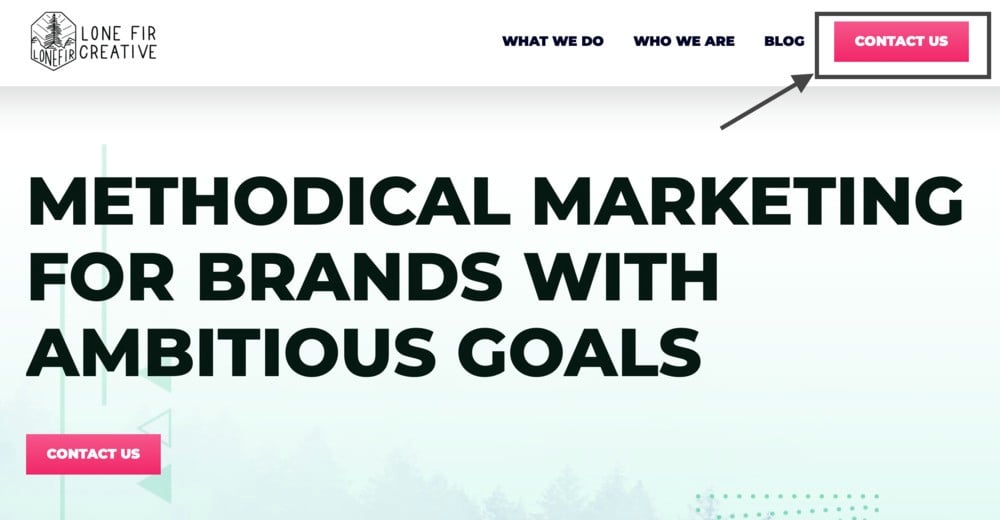Websites are one of the first interactions people have with a brand, making them a cornerstone of your digital marketing strategy.
If they are so important, why are most websites not focusing on the important stuff? There is a big difference between having a digital brochure and having a living, breathing website that is constantly working for you.
Sometimes, we just need a good filter to help us look at things with a better eye, so that we can see where the most impactful improvements can be made. Below are the most common website mistakes we see and how to fix them.
Messaging Mistakes
Using Confusing Language
When potential customers come to visit your website they are trying to figure out WHAT you do and how you can help them solve a specific pain point they are facing. Most of the time things are written and laid out in a way that is unclear to the visitor but makes perfect sense to internal stakeholders. Things can quickly get over-complicated. Users will leave your website still unsure of what you do and how you can help them, and that is an easy opportunity blown.
How can you fix it?
Keep things simple! Make sure your language is clear, concise and focused on the user’s problem. Even if what you do is complex, remember that simple terms are always best.
Not Making Your Content Skimmable
Do you really think people take the time to read each and every syllable on your website? In a culture that is fast past, people tend to just skim through your content. When people see big sections of text, it’s intimidating and unapproachable. It’s even likely that such a daunting task has caused them to lose interest and navigate away from your page.
How can you fix it?
Don’t make your users think. Create short, digestible sections of text that are supported with context clues such as images or icons. Make it easy for your visitor to understand what action they need to take to help solve their problem! Put yourself in your user’s shoes, is what you are writing down helping them on their journey? Or, is it solving a bureaucratic pain point within your organization?
You Don’t Address the Visitor
It’s very easy to get caught up in telling the user what you do and how you do it. But, don’t forget the old adage about cocktail parties, no one ever wants to hang out with someone who just wants to talk about themself.
Before tackling your site copy, you should have a firm understanding about what the user is trying to accomplish when they come to your site. So, help them on their journey.
They have likely landed on your site because you can help them address a very specific pain point they are facing, so be very explicit about how you can help and what the cost of inaction may be for them.
How can you fix it?
Be helpful.
Write copy that helps you empathize with your visitor’s pain point. Create resources that help them further diagnose their problem and provide valuable solutions. Lastly, answer as many questions as you can through solution-focused blog posts. The more you can position yourself as a valuable resource for your users, the more they will trust you and ultimately purchase from you.
👉 Keep Reading About Messaging: The Anatomy of a Winning Marketing Message
User Experience Mistakes
Obscuring the Call to Action
Each page of your website should have a singular goal. Your calls-to-action should reflect that goal.
Reducing your Calls to Action (CTAs) down to one per page (plus the one in your navigation) is one of the easiest ways to increase your site's conversion rate, yet it is often overlooked. Give your users a clear action they can take on each page of your site. Whether it's a button leading to your contact information or a form to schedule a demo, it should be obvious what they should do next.
How can you fix it?
When initially planning a site page, take time to determine the single action you want your users to take after viewing that single page. Then make sure the sections on that single page are helping users make an informed decision to take that action.
If you want to make a quick change, consider o adding a defined button to the right of our navigation menu so that your primary CTA is persistent and consistent across all pages of your site.

Not Leaving Enough White Space
Not leaving enough white space is perhaps one of the most common web design mistakes that we see.
White space is the space between headings, images, sections and other elements on your website, and it is one of the most important elements in modern website design.
White space gives your content room to breathe and allows the user to focus on the most important elements of the page. Combined with design elements, like high-contrast copy, you can focus the user's attention to specific areas of your page very organically.
How can you fix it?
Whitespace is your friend, it can only provide additional clarity around your content. Don't try to jam everything on your site into a single section on a page. Pay particular attention to brevity and skimmability by trimming down your content as much as you can. Allowing a little "extra" empty space between elements is not a bad thing!
Cluttered or Inconsistent Navigation
When you deem everything important, nothing can actually be important. The same goes for your website’s main navigation. The purpose of the main menu on your site is to make it as easy as possible for the user to get to the most relevant second page on their journey.
According to Hick’s Law, the more choices a person is presented with, the longer the person will take to reach a decision. That doesn’t mean you need to remove all the decisions, but you need to narrow them down to the very most important ones they can make at that moment.
How can you fix it?
Let your users tell you what options they need. Take a deep dive into your analytics and take an assessment of what your users are clicking on and how they are using your site. Is there any cleanup you can do to make their journey easier or faster?
Search Engine Optimization Mistakes
Search Engine Optimization (SEO) is one of the primary ways your website will attract traffic from users who haven't heard about your brand. If you don't put any resources into optimizing your website for search engines, you're missing out on a big source of new leads.
Forgoing a Keyword Strategy
Keywords are how Google knows what value you offer users. It identifies what you do, what you’re an expert in and in what scenarios the should display your content in search results.
Without any keywords on your site, you’re like a taco stand without a sign. No one will stop to buy your tacos because they don’t know you exist. In the digital age, a keyword strategy is how you can get in front of your customers and build trust before they ever have a conversation with you. Kind of like free samples...and who doesn’t love free samples?
How can you fix it?
Create a keyword strategy and start to write blogs that are relevant to your audience. These should not be sales pitches but should help and add value to the reader. It can take three to six months to get traction with SEO, but if you are consistent you will start to see your content climb the search engine rankings.
Mobile Optimization
Google cares about how your site looks on mobile because they know how much of the internet is accessed through the devices in our hands. In order to rank with authority, your site has to cater to mobile users just as effectively as desktop users.
Tap targets are one of the biggest elements that Google notes. Buttons, links and form elements should all be big enough, and far enough apart to make your mobile site as accessible to the user as possible.
How can you fix it?
Google provides a tool called a Lighthouse Report to help website owners identify how they can improve their websites. After running a report on your site, have a look at the opportunities to improve your site on mobile and get to work! A lot of times, elements simply need to be resized, which is a minimal lift from a development team.
Not Resizing Images
When you download a raw stock photo or even a photo from your phone, it is going to be a huge file. If you upload that to your website as is, it will increase your page load time and weigh down your site.
How can you fix it?
Resize and compress photos before uploading them to your site.. A general rule of thumb is to make sure images do not exceed 100KB each.
Leaving Extra Third Party Code and Plugins on Your Site
We’ve seen a lot of sites with old and unnecessary code from tools they’ve tried, but no longer use. Things like chatbots, heatmap software, popup addons, etc. This extra code increases your page load time and adds a lot of javascript weight.
How can you fix it?
Remove old code that doesn’t belong there anymore and evaluate your current tools to make sure they are all still in use.
👉 Check out our deep dive into SEO: Everything You Should Know About SEO
Performance Mistakes
No Responsive Design
These days, website visitors are visiting your site from mobile devices, tablets and desktops. While the split between those will vary by industry and location, you will always have users accessing your site from all three of these sources.
For a while, there was a trend of creating a mobile website just for users coming to your website from their phones. Many sites still use these to provide a clean and easy-to-navigate website on a small screen.
But as more and more devices and screen sizes were introduced, and more and more people started accessing websites from their phone, mobile websites just didn't provide the experience that was needed. Even more, creating a mobile website is like creating a second website, which is not very cost-effective.
Because of the wide variety of screen sizes out there now, a responsive website is a requirement in today's market. "Responsive" means that your website content will automatically adjust based on which size screen it's displayed.
How can you fix it?
There will always be tweaks needed to accommodate smaller screen sizes, but some designs and functionality just don't work on mobile. Make sure your website is designed with responsiveness in mind. Some elements just don't work across different size screens and shouldn't be included at all. But some elements are fine and just need specific tweaks to make them really work on smaller screens. Make sure your designer understands responsiveness and can advise you on how to best accomplish it in your design.
Not Tracking Your Website Performance
You'd be surprised at the number of websites we see without any sort of analytics running on them. Websites are not a 'set it and forget it' project. If you want them to perform at their best, you should be testing and evaluating what is working best and resonating with your target audience.
How can you fix it?
There are all sorts of tools out there to track your website's performance. But if you're just getting started, one of the easiest to install is Google Analytics. You want to install Google Analytics as soon as you can so it can start gathering data that you can analyze and use to inform your website optimization.
What Next?
Get moving! Even one of these adjustments can have a major impact on the overall usability of your website.
Just like outlining the goals of your pages, outline the internal goals your team has when it comes to your website, then prioritize. What is going to have the greatest impact the quickest? Start there.
And if you need help, shoot us a message! We have a number of different options when it comes to working with client websites. From monthly maintenance to full-blown website overhauls, our team loves to solve user-focused problems.








